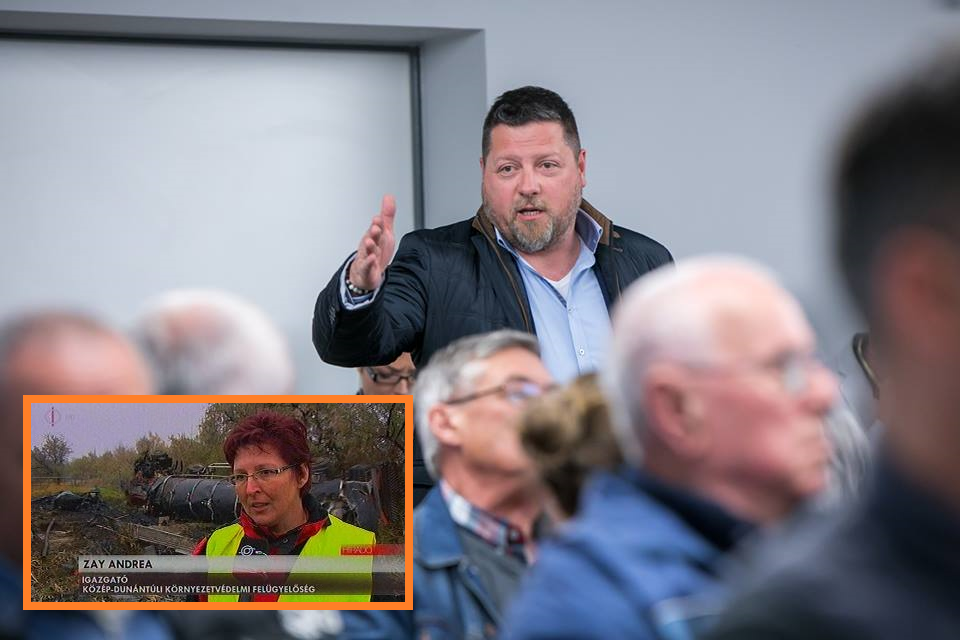The https://english.atlatszo.hu use cookies to track and profile customers such as action tags and pixel tracking on our website to assist our marketing. On our website we use technical, analytical, marketing and preference cookies. These are necessary for our site to work properly and to give us inforamation about how our site is used. See Cookies Policy
A pro-government official helped a town avoid an expensive cleanup of construction waste
Tens of thousands of cubic meters of possibly hazardous construction waste were deposited near lake Velence almost a decade ago. Despite an order by local environmental authorities, the local municipality cleaned it up only in 2015. A recent voice recording obtained by Atlatszo reveals that a pro-government leader of the local environmental authorities might have helped the town save money on the cleanup operations by allowing them to leave the waste in place and treat only a shallow layer and not dig 6-9 meters deep.
The previous mayor of Velence, Ágnes Oláhné Surányi allowed a company called Garten Coop to deposit construction waste near the lake in 2009. According to the local press, thousands of cubic meters of waste, concrete, rocks and textiles soiled with gasoline were deposited near the lakeshore.
An NGO reported this to the police at the time and the regional environmental authorities ordered the municipality of Velence to remove 16,900 cubic meters of waste, to dispose of the waste properly and to restore the area to its previous state. The mayor appealed the decision, arguing that other municipalities were involved as well.
The decision by the authorities ordered the waste to be cleaned up in 2012 but the work was only finished in 2015.
According to a permit by the local environmental authorities, signed by Dr. Andrea Zay, the soil did not have to be transported to another location but was allowed to be put back after treatment. Also, the soil needed to be excavated and treated only 50-70 centimeters deep, instead of 6-9 meters.
According to a voice recording of mayor András Koszti that was obtained by Atlatszo, the fact that the soil did not have to be transported and only a shallow layer had to be treated saved 300 million HUF to the town.
’If the chairwoman of the local environmental authority had not been called Dr. Andrea Zay at the time, then the town would be bankrupt now. Everybody knows that everything was dumped there when the highway was built and when the railway was reconstructed. (…) We managed to reach a deal where only 50-70 centimeters had to be recultivated. That means we saved money by not having to transport the waste from there to another location and by not having to recultivate 6-9 meters deep. (…) I am saying this again, if it was not for Dr. Andrea Zay, who supports Fidesz, and who supported us in this and to whom we are very grateful, then it would not have cost 30 million but more than 300 million’ the mayor says in the voice recording. He said these at a local Fidesz party meeting this spring.
Andrea Zay was a Fidesz candidate for MP in 1998 in Heves County. Velence mayor András Koszti is a member of Fidesz.
We reached out to both Koszti and Zay for comments; they have not replied to our requests so far.
Contemporary news reports suggest that the case was much bigger: news stories described more than 100 thousand cubic meters of waste deposited across three counties and police were investigating eight companies in the case.
In the end, two companies were forced to pay a fine that totaled more than 500 million HUF. The municipality of Velence also lost in the case.
Atlatszo got hold of the original documents in the case. One of the documents states that, according to Garten Coop, the environmental authorities did not examine the role of other companies, including Femol ’97 in the case.
Femol ’97 is today called R-Kord, and is one of the jewels of Lőrinc Mészáros’s business empire. However, back in 2013 when the construction waste was deposited in Velence, Femol ’97 was not yet owned by Mészáros. He only bought the company two years later.
The owners at the time, the Molnár family, were also living in Felcsút. Csaba Molnár was the chairman of Felcsút Sports Club and Femol ’97 was one of the main sponsors of the club. They were also doing business with Orban’s father’s stone mine.
According to a story in Magyar Narancs it was the investigation into the Velence case that financially weakened Femol ’97 and made it possible for Mészáros to buy it. According to an official document that was obtained by Atlatszo, Femol ’97 was given 214,7 million HUF fine in the case.
A court annulled the latter decision, but by this time no bank was willing to give credit to Femol ’97 and it was financially in ruins.
Today, years after the case it is very hard to reconstruct which company was responsible for the construction waste that was dumped near the lake. Some of it came from the railway reconstruction works between Székesfehérvár and Tárnok.
According to the companies at the time, the construction waste deposited near the lake was not hazardous. However, according to the document that orders Garten Coop to pay a fine of 351 million, the waste contained a significant amount of geotextiles and gasoline.
Whether the waste toxic or not is key: this is one of the areas that host a student festival called EFOTT.
Written by Zsuzsa Bodnár and Antónia Rádi
English version by Anita Kőműves. You can read the original, Hungarian-language story here.
Cover image: András Koszti/Facebook


